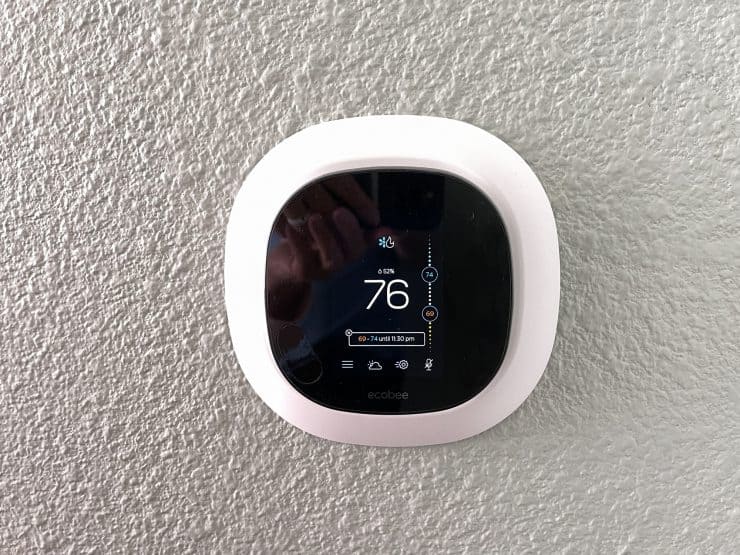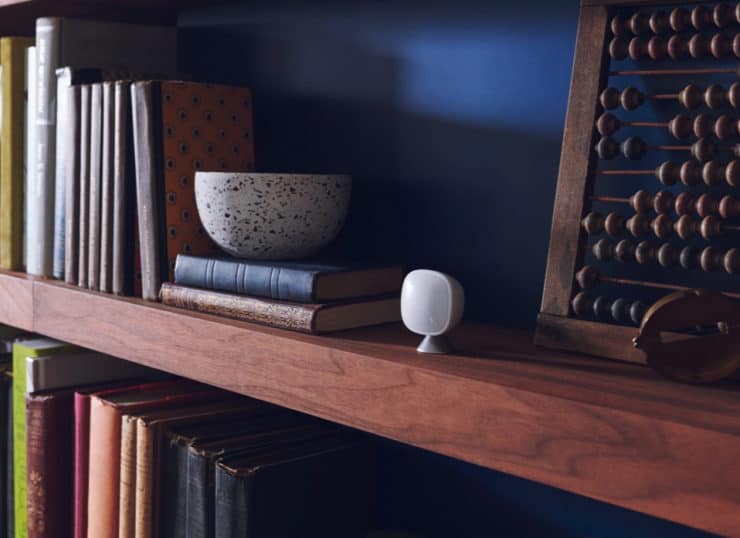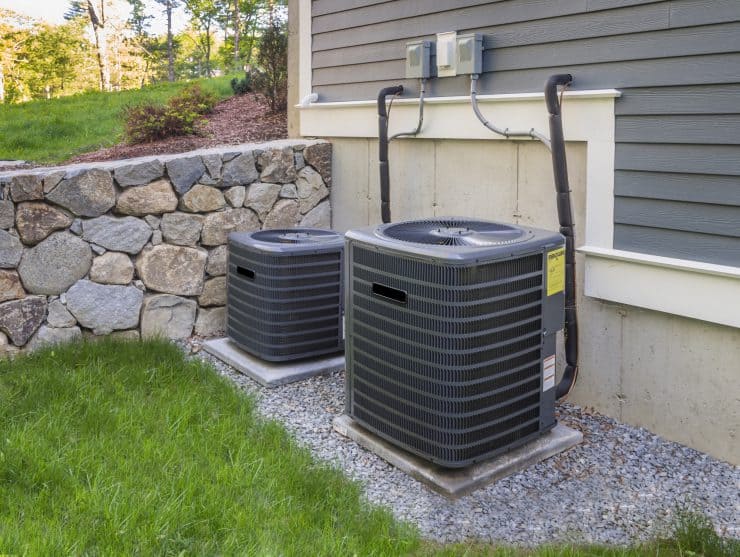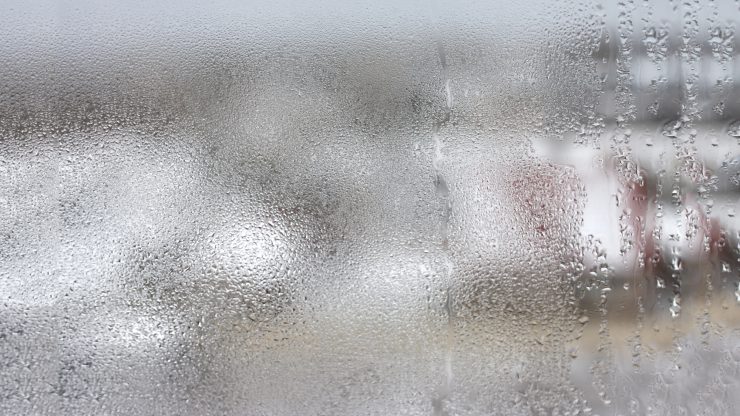The ecobee smart thermostat is one of the leading choices when it comes to bringing some elegance to your HVAC system. This smart thermostat comes packed with features that handle everything from learning your daily routine to nuanced scheduling options.
On the top of every homeowner’s mind is humidity. Not only is this about comfort, but if your HVAC system isn’t properly handling this build up of moisture, you could be looking at some serious repair costs down the road. Luckily, the ecobee can help you tackle this problem.
The ecobee smart thermostat has built in settings that can fine tune your home’s humidity. Even if you do not have a dedicated dehumidifier, the ecobee smart thermostat can help you better manage your home. These settings range from fan controls to HVAC settings.
What is the ecobee Smart Thermostat?

This is one of the premier options for people who are searching for the right smart thermometer.
Not only does the ecobee come with all of the standard features any regular thermometer should have, it also comes with plenty of smart features that let you get the granular control smart home enthusiasts are looking for. This device also integrates with all of the latest smart home apps and hubs including:
- Alexa
- Google Assistant
- HomeKit
- Samsung SmartThings
One of the biggest questions that homeowners have is in regard to how well the ecobee can control humidity.
Humidity build up can cause your HVAC system to work overtime, so it can overcome rapidly changing moisture levels in the air. It can also lead to serious problems such as rot and water damage if the humidity gets severe. Your ecobee can help you keep this humidity in check.
Here’s how to get started.
How Does It Measure Humidity?
Let’s start with the quick overview of the basics. The ecobee measures humidity by using a built-in sensor within the thermostat itself. However the ecobee smart sensors do not collect humidity data.
These smart sensors can, however, measure temperature and occupancy:

But because they don’t measure humidity, it’s important to have your ecobee thermostat(s) in a position which have fairly normal levels of humidity. Don’t go installing it in your shower, for example!
Some users experience discrepancies with the humidity readings on their ecobee and what other devices show around their home. The quick fix here is to calibrate and sync your ecobee devices – this is usually a one-time step when setting up your system, and should take up to 20 minutes. This should quickly eliminate any major discrepancies and get your ecobee system back on track.
You can also use the Humidity Correction setting to change the setting up or down by 10% if you require.
Now that we know how the ecobee works, how does it control our home’s humidity?
Does ecobee Control Humidity?
Yes! The ecobee smart thermostat can control the humidity in your home. Most of its power to control your humidity comes down to your HVAC system.
Your ecobee is a very intelligent brain that you can plug into your existing HVAC system. The ecobee comes packed with features that can min/max your ability to control your home, but if your HVAC system is outdated or flagging it will naturally limit what your ecobee is capable of. It pays to keep your HVAC system up-to-date when you are adding in a smart thermostat system like ecobee.
When your ecobee is plugged in, it can manage humidity in a variety of ways. The ecobee can be connected into a variety of home environment accessories such as dehumidifiers. These devices directly lower the humidity in your home.
Your ecobee, by default, is already plugged into the most powerful dehumidifier money can buy, and that’s your AC system. Your ecobee will primarily regulate humidity by making granular adjustments to your home’s AC:
Having all this power is all well and good, but how accurate is the sensor we are working with?
How Accurate is ecobee’s Humidity Sensor?
The humidity sensor in the ecobee is typically very reliable. This sensor is responsive to changes in your environment and can be calibrated as well as synced with other devices. This means that you can make sure that your ecobee is always within a few units of accuracy.
While the exact specs on the ecobee humidity sensor are kept secret, we can make some inferences using the available information on the temperature sensor.
The ecobee thermostat is accurate within +/- 1.0F according to official documentation. The temperature sensor uses the last two measurements to create an average that it uses to stay calibrated. It also takes these measurements every 15 seconds under the default settings.
What this tells us about the humidity is that we can expect a respectable accuracy for most circumstances. A temperature variance of 1 degree isn’t too extreme and as long as the humidity readings are in line with that, we are good to go.
So, how do we get in control of our humidity?
How do I Adjust/Lower the Humidity on My ecobee?
Let’s start with the “coolest” setting your ecobee has: Overcool Max!
No, Overcool Max isn’t an 80s comic book hero, it’s actually the setting that your ecobee will use to regulate your humidity.
What this setting does, essentially, is give your HVAC system permission to get cooler than your set temperatures to regulate your humidity. You have two options for controlling the radical powers of Overcool Max.
The first is to directly set how many degrees your HVAC system can overcool to compensate for humidity. This can be set in .5 degree increments. So, if your home gets too humid, your ecobee will tell the HVAC system that it has temporary permission to increase the chill until the humidity is back under control.
Setting your desired humidity level is also easy. That’s under Menu > Dehumidify using AC > Enable. Under this setting you can pick a percentage for your home’s humidity. You can go bone dry or tropical based on your needs. This setting will also be the percentage that the Overcool Max setting uses to determine when your AC can put in some extra work to fight off the humidity.
Keep in mind that Overcool Max will turn off either when the temperature setting or the humidity percent is reached. Whichever happens first. So it might not get the ideal humidity if it can’t get cool enough.
Another setting to look out for is the ever useful, but much less awesomely named, fan settings.
Always On VS Auto Fan and Humidity
Your fan settings won’t be getting an action movie deal any time soon, but this is the setting that is really putting in the work for your humidity. Here’s how it works.
If you have the fan set to always on, it will constantly cycle humid air throughout your home. Over time, this will increase the humidity. Auto fan allows the fan to stop and humidity to condense inside your HVAC system. Your HVAC equipment has built in tools that allow it to deal with that moisture. Basically, auto fan lets your HVAC cycle out unwanted humidity while always on slowly builds humidity back up.
Now let’s look at the most powerful anti-humidity tool in your arsenal: the AC.
Dehumidify Using AC Setting

Your AC has the ability to shut down humidity and do it fast. Here’s the science behind it.
Cold air can’t carry nearly as much moisture as warm air. This is why you tend to get dryer skin in the winter. The air just can’t hold the same amount of moisture as it can when it’s hot out. Your HVAC system takes advantage of this by using your AC to lower the humidity in your home.
For your ecobee, simply drop the temperature a few degrees, and you can send the humidity packing. Keep in mind that if it’s already cold outside, or you’re in a tropical heat wave, your AC might struggle to keep the humidity and the heat at bay.
What should you use all this power to set your humidity to?
What Is A Normal Indoor Humidity Reading To Aim For?

When it comes to ideal temperature, that’s easy! Just pick whatever makes you feel good! Are you a sunbathing hot weather all-star? Then turn it up. Are you looking to keep your cool on a hot day? Then spin that dial to the left. Those of us that enjoy a balanced energy, and financial, usage can just take back Mother Nature’s edge on harsh days.
But the story changes for humidity.
The ideal relative indoor humidity is a percentage, and it varies pretty wildly based on your needs, where you live, and your home.
According to the Mayo Clinic, the ideal humidity will be between 30% and 50% for most indoor environments. Although some experts say that up to 65% is also okay!
Part of this swing, like temperature, comes down to comfort. Some people like it a little more humid, and others like it a little dry. Personal considerations like health come into play as certain conditions can be triggered by the wrong humidity.
How your home is built is another thing to keep in mind. Older homes were built to retain heat more efficiently, and they can also retain humidity much easier as a side effect.
In short, your ideal humidity percentage will be somewhere in that 30% to 65% range depending on your comfort, your home, and your needs. Feel free to play with that number as the seasons change and find out what works best for you.

I live in the desert. Can I add more humidity in my home using the ecobee 5? Thank you.
I believe you can, as this comes down to setting the correct target humidity – you’ll want to set it higher than the current humidity. But be sure to disable features like AC overcool which can still act to decrease humidity.
Will this thermostat work with Arcoaire FEM4P1800AL to control/reduce humidity?
Apologies but you’d probably be better off asking Ecobee’s support. There’s not much information about the Arcoaire FEM4P1800AL system online, but their direct support may know more.
I have my humidity insides set at 45 that a good setting
Glad to hear that a 45 humidity level works well for you, thanks for the comment Marsha!
Hate to be that guy but you need to hire a proofreader because the opening paragraph alone has two typos, one of which changes the entire meaning of the sentence (“inelegance”).
Thanks for the helpful comment, and you’re quite right – it’s not good for me to publish articles with typos. Those specific cases are resolved now (thanks again), but I agree that a proofreader of sorts will also be important to explore.
Your information is incorrect on the Smart Sensors, they detect occupancy and temperature ONLY, not humidity. Humidity is only done at the thermostat itself.
Whoops, my bad. Thanks Guy, this has been updated now.
After reading this article, we settled on Ecobee for the humidity controls because we can enjoy high tempartures as long as the humidity is kept in check. However, the Ecobee only controls the humidity when the temparture in the house goes over your set thermostat temperture so basically doing what a normal thermostat does, at least, what our thermostat has been doing and confirmed by the Ecobee Rep. So basically, if the humidity would be controlled even in between your set thermostat set points then the humidty control feature would be useful but it isnt.
Ah, that’s an interesting point – thanks for flagging that up. Yes it’s frustrating but it does seem like Ecobee need to do a bit more work in this area.
I’m certainly no expert but it seems it really depends on your equipment. I have 3 ecobee thermostats on 3 very different units both in age and sophistication. The oldest unit it really can’t help much. The second unit is helped by cycling on for up to 5 degrees cooler to get the humidity down and seems to work fairly well. The newest unit is where ecobee shines. It has a 2 speed compressor and variable speed air handler. The ecobee manipulates this combination very very well. It will give us much higher temps with much lower humidity. That’s what it’s supposed to do and it can do it. But it can only work with what you give it.
Ah that’s a good point, yes it does seem to be something that ecobee have refined a lot in each generation of their thermostats. Thanks for the comment!
My Ecobee Keeps saying 71%. What do I do?
I have the same issue. It reads humidity levels in the 60s or 70s, but I know actual humidity is around 40% given the northern US winter season. Ecobee customer support could not resolve and advised me to do an exchange at the point of sale. I did, and the second one is behaving the same way.
Thanks for sharing your experience too, it definitely seems like a bug with Ecobee’s software (or a design issue with the sensor, although that might be less likely) which is frustrating. I hope it can get sorted soon in soem way.
Having read all the comments made by users of the Ecobee systems it would appear that Ecobee hasn’t refined the sensors for the humidity in the thermostat units.
I am interested in getting a unit that will sense the inside humidity in the home when the outside temperature is below -40 degrees celsius and up to +15 degrees. Come May to October humidifier is not required in Alberta and we normally shut it off.
It doesn’t make sense to me to buy a system that is only guessing what humidity is required to keep my home safe and properly humidity maintained.
Ron from Alberta
Can Ecobee lower the humidity setting when the outdoor temperture falls below -25C? At that temperature, we get a lot of window condensation.